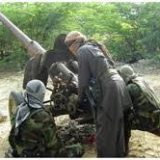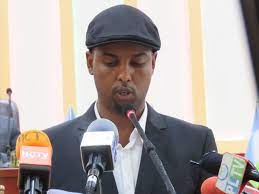The long route from Somalia to the U.S. passes through this Panamanian jungle
Somalis on the beach!” the boat captain yelled over the growl of his 275-horsepower engine. I followed the line of his pointed finger to a group of strangers wading ashore through the weeds.
Tim Rogers
Somalis wade ashore in the Kuna Yala
“Vamos pa’ alla, pue,” I shouted back. The captain dutifully throttled back on the engine and swung the boat toward the bank of the lagoon, where the men were crawling onto the green embankment and emptying the water from their rubber boots.
Tim Rogers
Somali man empties river water from his jungle boots
“Are you Somalis?” I asked the nearest man, as I jumped ashore next to them.
“Yes” he answered, lying back in the grass, visibly exhausted. “We’ve been lost in the bush for eight days.”
Tim Rogers
Somalis rest on the beach
“We’ve been hearing this music since yesterday,” added a second man in a yellow Puma hat, as he nodded sadly towards an unseen source of fast-tempo Caribbean beats undulating through the trees that separate the beach from the village. “We’ve been walking and walking, crossing rivers up to our necks. Trying to avoid snakes. We never realized we were going in circles.”
“We can’t walk any farther,” interrupted a third man, a tall, skinny guy who spoke a more deliberate and stilted English. “We. Need. Help. Is there a refugee camp near here?”
Tim Rogers
Yussuf meets local Kuna kids on the beach
Allow me, Gentle Reader, to pause the story here for one moment. It might seem strange that the boat captain and I assumed a group of weary, dark-skinned travelers passing through one of Central America’s meanest jungles were Somalis. It might seem even stranger that we guessed right.
But these are strange times for global immigration, and Panama is playing a leading role as a natural bottleneck in the flow of people traveling from South America to North America. This umbilical Central American country, which has long been an East-West waterway for international trade, is also a South-North land bridge for people from all over the world heading to the United States in search of a better life.
Many immigrants moving through this region are traveling without authorization, which is why they cross the border at unguarded blind spots. And there’s no blinder spot in Panama than the Darién Gap— a dense 4,600 square-mile swath of jungle where it’s just as easy to hide as it is to get lost. This is where the sidewalk ends. Here there are no roads, no cellphone service, no internet, and no power grid. Most beers are served lukewarm.
Omar Bustamante
I was in a southern section of the jungle known as the Kuna Yala (or Guna Yala, for those who like to remain current on their spelling) looking for Cubans, who have been trekking through the forest in record numbers as part of an improbable “land route” from Havana to the United States. In just three days I found more than 700 Cuban immigrants in the Panamanian jungle, most of whom were stuck in the bordertown outpost of Puerto Obaldia, trying to get family in the U.S. to wire money so they could continue north after getting robbed clean in Colombia.
Tim Rogers
Cubans immigrants hanging out in Puerto Obaldia, trying to get out of Panama
But Cubans aren’t the only unexpected group of foreigners passing through this jungle. Due to evolving global immigration routes, this remote patch of boscage has become a bizarrely cosmopolitan crossroads for people from all over—including folks from as far away as Nepal, Bangladesh and Somalia. The leader of the Kuna community I was staying in told me that several groups of Somalis had wandered out of the jungle and into his village last month. I hoped I’d be lucky enough to be there the next time it happened. I was. Now back to our story.
“How long have you guys been traveling?” I asked 23-year-old Yussuf, who seemed to have the best grasp on English of the six Somalis in his group.
Tim Rogers
After 8 days in the jungle, Yussuf was tired and dirty and nearly ready to call it quits
“Two-and-a-half months,” he said. “I started in Bolivia and met these guys along the way. We met her yesterday.” Yussuf nodded to the seventh travel mate, who was clearly Latina. “We found her crying in the jungle by herself. I don’t know what language she speaks. We can’t communicate.”
“Como te llamas?” I asked the woman.
“Carolina.”
“De donde eres?”
“Dominicana,” she said.
After establishing a few other basic facts, I asked Carolina how a 33-year-old woman from the Dominican Republic ended up trekking through the Panamanian jungle with a group of Somalis. Her answer made about as much sense as the question. She spun a yarn about how she had been in Colombia visiting a friend and then attempted to cross into Panama to visit her aunt but got robbed at the border and dumped in the jungle without any money or identification.
The Kuna gathered around me on the beach told me later that night, over lukewarm beers, that they suspected her of being a member of the FARC, a Colombian rebel group that’s known to be in the people-smuggling business. “Carolina,” the villagers said, could be a coyote hired to lead the Somalis through the Darién Gap. The story about the Somalis finding her crying in the jungle was just cover, and her accent wasn’t convincing, they said.
It was another confusing twist in a bizarre story filled with details that didn’t seem to hold up particularly well under scrutiny. Another dubious detail is that Yussuf’s journey started in Bolivia, since there are no direct flights from Africa to Bolivia. He probably meant Brazil, a more common trailhead for undocumented Africans migrating to the United States. But we’ll get back to that in a minute.
The only thing I knew for sure was that I was standing in the Panamanian jungle talking to six Somalis, and I was dying to know how they ended up lost in the bush, 8,700 miles from home.
Getting their story, however, would take some doing. The Panamanian Border Patrol—dressed in full combat fatigues and floppy jungle safari hats—quickly swooped in to take the Somalis and the alleged Dominican into custody by marching them through the Kuna village to the police station, which is protected by deep trenches lined with sandbags, as if they were expecting an invasion by the Kaiser’s troops at any moment.
Tim Rogers
Somalis follow police into the Kuna village
I was told to scram, but decided to loiter helpfully nearby, in case my translation services were required. Luckily, they were. After an hour of meaningless hand gestures and exasperated nose-wrinkling between the Panamanian police and Somalis, I was asked to translate from Kuna to Somali (just kidding, from Spanish to English). It gave me a chance to spend the rest of the afternoon with the Somali refugees in the police station, which is about the second most fun you can have in town on a Friday afternoon, after the Chicha Brava fiesta.
Dude, how do I find you on Facebook?
I immediately liked Yussuf, the friendly Somali who spoke the best English in the group. He forever endeared himself to me when we were escorted through the Kuna village by police and he stopped momentarily in his tracks to express bewilderment at the sight of a pickup volleyball game. “Boys and girls playing sports together?!” He asked me, mouth slightly agape.
Tim Rogers
Boys and girls playing volleyball together, unbelievably
I took private delight in the idea that a lost Somali man who was being escorted by border patrol agents through a Panamanian indigenous village thought a coed volleyball was the weirdest thing going on around him.
Anyway, when I was eventually pressed into translation duty at the police station, I got a chance to ask Yussuf how he had arrived in Panama. His story was almost crazy enough to be believable.
Yussuf said his father had been a camel trader in Somalia. When his dad died he inherited the family herd. Earlier this year he says he was approached by a Somali guy who promised to get him papers to emigrate to the United States. Since his parents were dead, and Somalia isn’t exactly an up-and-coming spot for a young man with aspirations, Yussuf decided to pull up stakes and try to find his cousin in Minneapolis.
Tim Rogers
Somalis on the beach
“If you have the opportunity to leave Somalia, you go,” he said.
Yussuf said he sold his family’s remaining camels for $13,000 and then forked over $5,000 to the coyote who promised to get him to the Americas. He said the African-trafficking network facilitated him with a fake passport and paperwork to get to “Bolivia” via South Africa. At the Johannesburg airport, just prior to boarding the plane, Yussuf said he handed off his false passport to a mystery man loitering in the departure lounge, then boarded the plane without any documentation.
When he arrived—in whatever country it was that the plane landed— he handed immigration officials a pre-prepared letter in Spanish asking for asylum. He says the officials, in turn, gave him a safe-passage permit that gave him five days to leave the country—enough time to continue his undocumented journey north. The details of his travel through South America are a bit fuzzy, perhaps due to exhaustion, or language, or by design. Maybe all three.
Omar Bustamante
The Somalis Immigration route, according to Yussuf, who might have confused Bolivia for Brazil
In any event, he eventually made it to Panama. And when I met him in the jungle, he said he had been on the road for 11 weeks. At that point, Yussuf said he was nearly ready to call it quits. He told me he lost most of his money to bandits in Colombia and hadn’t slept well in several nights, kept awake by rains. He had long ago eaten his last can of tuna fish, and had been drinking river water for several days. He had sand on his face, and his clothes were filthy and wet.
I gave him a plastic laundry bag from Panama City’s Trump Ocean Club Hotel to keep his remaining possessions dry as he continued to make his way to the United States. Donald would have been proud.
“Would you have attempted this trip if you had known how difficult it would be?” I asked.
“No,” Yussuf answered directly.
We blinked at each other silently for a few moments.
“When do you go back to America?” he finally asked me.
“Sunday,” I said.
“We still have more than a month left in our journey, if we don’t get caught and deported first,” he said.
“It doesn’t seem fair,” I said.
“It’s not fair,” he agreed.
The next day, after the Somalis spent the night in an outdoor rancho at the police station, the Panamanian officers were eager to get rid of their African guests. Legally, the undocumented Somalis can’t be in the country. But legally, they can’t really be anywhere, and they’re too far from home to deport. Panamanian police, therefore, have decided the best thing they can do is quietly turn a blind eye and shoo them on their way through the jungle.
After negotiating a fare with a local boat captain, we took Yussuf and his fellow travelers 10 miles up the coastline to the mouth of the Rio Pito, where they would have to continue a three-day trek into the unforgiving, mountainous wilds of the Darién Gap. They wouldn’t see another village for 15 hours, the Kuna guide told me.
Tim Rogers
Yussuf looks out at the jungle as we motor up the coastline
As the Somalis prepared to depart, I told Yussuf I’d like to look him up someday in Minneapolis to see how he’s adjusting to his new life in the U.S. They were awkward words of departure, intended partially as encouragement and partially because I meant it. Yussuf nodded and gave me his Facebook name and instructions on how to find him. I did the same.
Tim Rogers
Somalis head off into the Darien Gap
“I’ll send you a friend request,” I promised. “Accept it when you get to Minneapolis, that way I’ll know you made it.”
Yussef beamed a full-toothed smile and nodded silently. Then he turned with his crew, walked 500 meters up the rocky beach, and disappeared into the verdant thicket of jungle.
Tim Rogers
Back into the wilderness
I really hope we become Facebook friends someday.


































